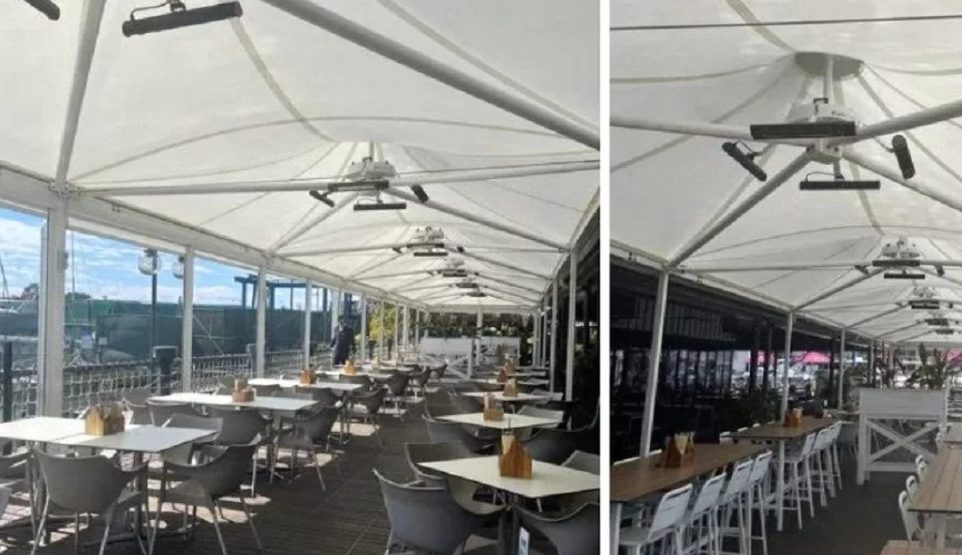YOU ARE HERE:

Exploring Commercial Shade Structures: Cost, Materials, Types, and Installation
Jamie Howard In Commercial Shade Structures
Commercial shade structures have become essential additions to outdoor spaces, providing protection from the scorching sun and other environmental elements while enhancing aesthetics and functionality. Whether you’re looking to create a comfortable outdoor dining area, offer shade to customers waiting in line, or provide shelter for equipment and vehicles, a well-designed commercial shade structure can transform your space. In this article, we’ll delve into the cost considerations, materials, types, and installation methods for commercial shade structures.
How much does a commercial shade structure cost?
The cost of a commercial shade structure can vary significantly depending on several factors, including size, design complexity, materials used, and location. On average, you can expect to invest anywhere from $5,000 or more for a basic commercial shade structure. However, larger and more intricate designs can push the cost well beyond this range.
Factors influencing the cost of a commercial shade structure:
⦁ Size: The size of your shade structure is one of the most significant cost determinants. Larger structures naturally require more materials and labour, leading to higher costs.
⦁ Design Complexity: The complexity of the design, including the shape, number of posts, and custom features, will impact the cost. Intricate designs may require more time and specialized construction skills, driving up the price.
⦁ Materials: The choice of materials plays a vital role in cost. Common materials for shade structures include fabric, steel, aluminium, and wood. Each material has a different price point, with steel and aluminium often being more expensive than wood or fabric.
⦁ Location: Your geographical location can affect the cost due to variations in labour costs and permitting requirements. Areas with a higher cost of living typically have higher labour costs, which can influence the overall price.
⦁ Installation: Professional installation adds to the cost, but it ensures that the structure is safely and securely erected. DIY options may be cheaper upfront but could lead to long-term issues if not installed correctly.
To get an accurate cost estimate for your specific project, it’s advisable to consult with experienced shade structure contractors or suppliers. They can provide a detailed quote based on your requirements and location.
What is the best material for a shade structure?
Choosing the right material for your commercial shade structure is crucial, as it directly impacts durability, aesthetics, and maintenance. The best material for your shade structure depends on your specific needs and budget. Here are some commonly used materials:
⦁ Fabric:
⦁ Pros: Lightweight, versatile, and available in various⦁ ⦁ colours and patterns. Provides excellent UV protection.
⦁ Cons: May require more frequent replacement compared to some other materials. Not as structurally robust as metal options.
⦁ Steel:
⦁ Pros: Extremely durable and long-lasting. Can withstand harsh weather conditions. Suitable for large and permanent shade structures.
⦁ Cons: Heavier and more expensive than other materials. May require periodic maintenance to prevent rust.
⦁ Aluminium:
⦁ Pros: Lightweight, corrosion-resistant, and highly durable. Ideal for both temporary and permanent installations.
⦁ Cons: Can be more expensive than steel. May not be as strong as steel for extremely large structures.
⦁ Wood:
⦁ Pros: Natural and aesthetically pleasing. Well-suited for rustic or traditional settings.
⦁ Cons: Requires regular maintenance, including sealing and staining. Not as durable as metal options.
⦁ PVC/Polyethylene:
⦁ Pros: Affordable and lightweight. Resistant to moisture and UV rays.
⦁ Cons: Not as durable as metal options. May degrade over time due to exposure to the elements.
Ultimately, the best material for your commercial shade structure depends on your budget, the intended use, and the climate of your location. For coastal areas with high humidity and salt exposure, corrosion-resistant materials like aluminium or stainless steel are recommended. For temporary structures, fabric or PVC can be cost-effective choices.
What is a shade structure called?
Shade structures come in various forms and serve different purposes. Depending on their design and function, they may be referred to by different names:
⦁ Shade Sail: A shade sail is a versatile and aesthetically pleasing shade structure consisting of a fabric canopy stretched between multiple anchor points. They are often used in outdoor settings and can be configured in various shapes and sizes.
⦁ Pergola: A pergola is an open-air structure with an overhead lattice or crossbeam arrangement. While it provides some shade, its primary purpose is to define outdoor spaces and add architectural interest.
⦁ Cantilever Umbrella: These are large, free-standing ⦁ umbrellas with a cantilevered design. They are commonly found in outdoor dining areas and poolside spaces.
⦁ Gazebo: A gazebo is a freestanding, octagonal or hexagonal structure with a roof that provides both shade and a sheltered gathering space.
⦁ Ramada: Often used in desert climates, a ramada is a type of shade structure with a solid roof and open sides. It offers protection from the sun while allowing for natural ventilation.
⦁ Shade Structure Canopy: This is a general term for any structure designed to provide shade. It can encompass a wide range of designs, including fabric canopies, solid-roofed structures, and more.
How to build a shade sail structure?
Shade sail structures are popular choices for their flexibility and modern aesthetic. Building a shade sail structure involves several key steps:
⦁ Planning:
⦁ Determine the location and size of your shade sail structure.
⦁ Identify suitable anchor points (e.g., posts, walls, trees) for the corners of the sail.
⦁ Selecting Materials:
⦁ Choose a ⦁ high-quality shade sail fabric. Ensure it is UV-resistant and durable.
⦁ Select ⦁ appropriate hardware, including turnbuckles, D-rings, and tensioning devices.
⦁ Installation:
⦁ Install the anchor points securely, ensuring they are level and plumb.
⦁ Attach the shade sail fabric to the anchor points using D-rings or similar hardware.
⦁ Use turnbuckles or tensioning devices to tension the sail fabric evenly. This step is crucial for achieving a taut, wrinkle-free appearance.
⦁ Maintenance:
⦁ Regularly inspect the shade sail for signs of wear, such as fraying or stretching.
⦁ Clean the fabric as needed to remove dirt and debris.
⦁ Professional Installation:
While DIY installation is possible for small shade sail structures, it’s advisable to consult with professionals for larger or more complex installations. They have the expertise to ensure proper tensioning and long-term durability.
Conclusion
Commercial shade structures offer numerous benefits, from enhancing the comfort of outdoor spaces to providing protection from the elements. When planning a commercial shade structure, it’s essential to consider factors such as cost, material selection, type of structure, and installation. By carefully assessing your needs and consulting with experts, you can create a shade solution that not only adds functionality but also enhances the appeal of your commercial space. Whether you opt for a shade sail, pergola, or another type of structure, a well-designed shade solution will undoubtedly benefit your business and customers alike.
Share:
Jamie Howard - Director
Co-founder and Director Jamie has been hands-on in the shade and steel industry since leaving school. With over 15 years’ experience in shade, membrane and steel projects, Jamie is excited about the design opportunities shade structures offer in the commercial and industrial sectors. Jamie’s extensive design skills give him a competitive edge in situations with technical design complexity. He has won two personal industry awards for his designs, alongside many company-won awards.

